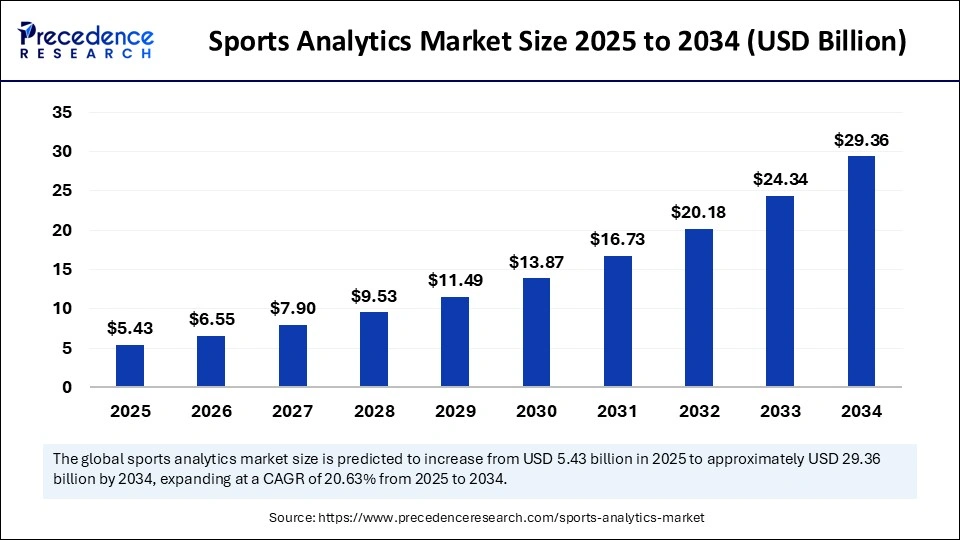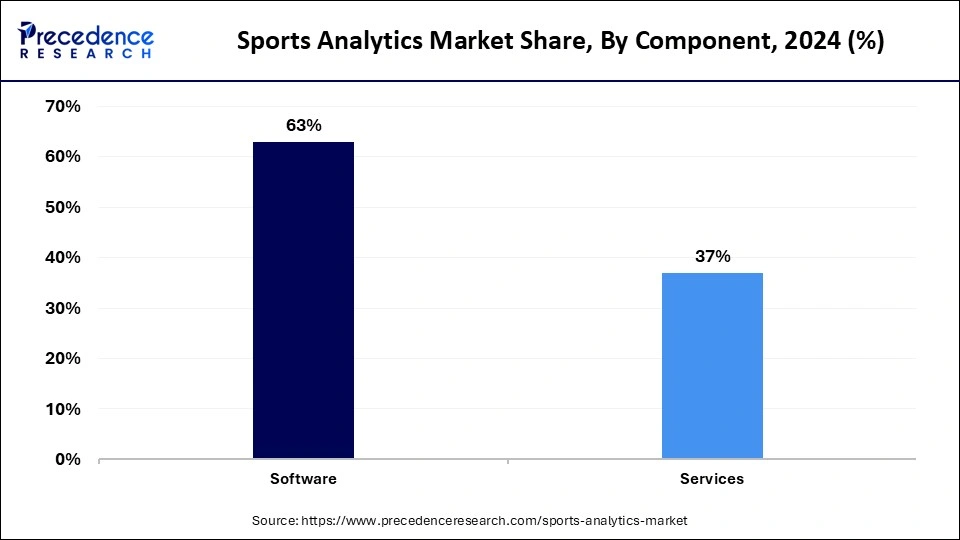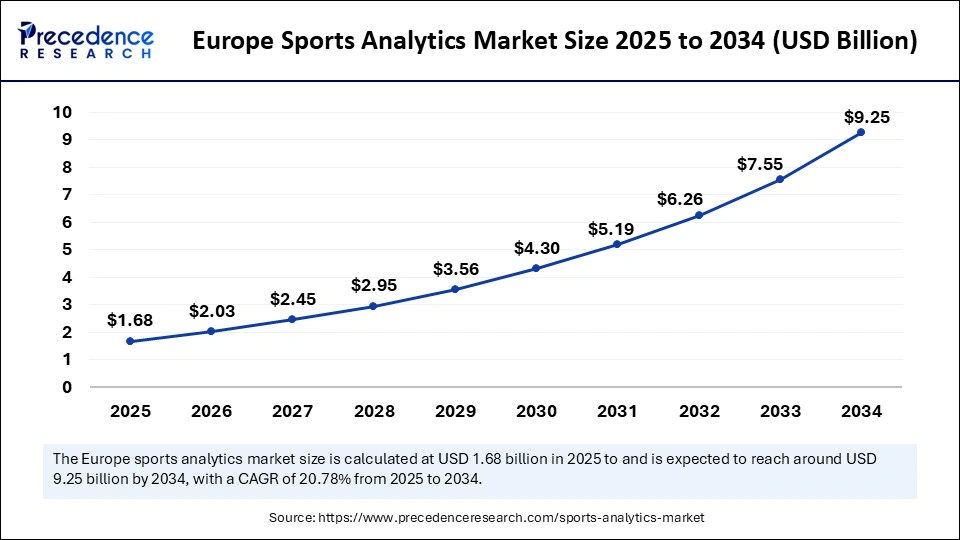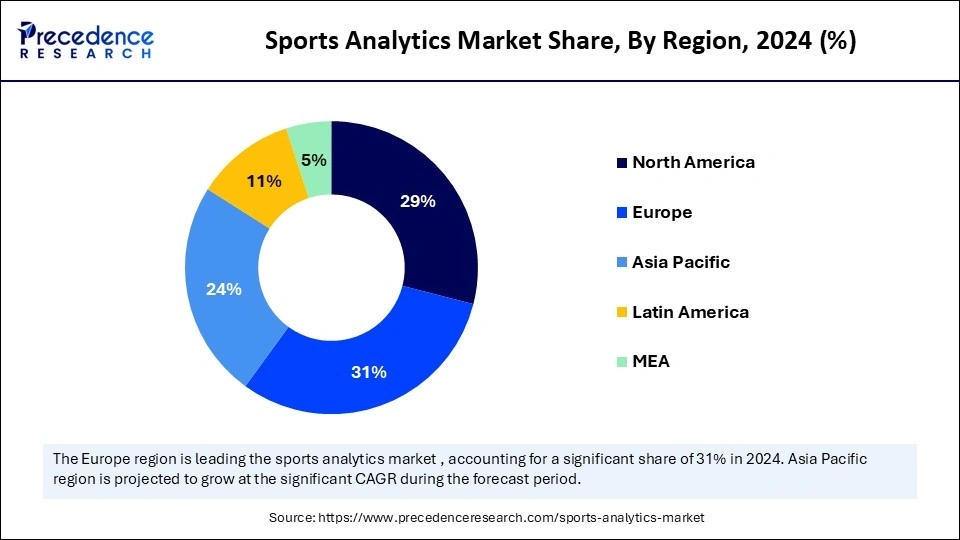List of Contents
What is the Sports Analytics Market Size?
The global sports analytics market size is calculated at USD 5.47 billion in 2025 and is predicted to increase from USD 6.60 billion in 2026 to approximately USD 29.75 billion by 2034, expanding at a CAGR of 20.63% from 2025 to 2034. The growth of the market is attributed to the rising need for solutions to track player performance and optimize strategies.

Sports Analytics Market Key Takeaways
- In terms of revenue, the sports analytics market is valued at 5.47 billion in 2025.
- It is projected to reach 29.75 billion by 2034.
- The market is expected to grow at a CAGR of 20.63 % from 2025 to 2034.
- Europe dominated the global market with the largest market share of 31% in 2024.
- Asia Pacific is expected to grow at the fastest CAGR of 22.84% during the forecast period.
- By component, the software segment captured the biggest market share of 62% in 2024.
- By component, the services segment is expected to expand at a rapid pace in the upcoming period.
- By analysis, the off-field segment held the largest market share in 2024.
- By analysis, the on-field segment is expected to register the fastest CAGR during the forecast period.
- By sports, the cricket segment led the market in 2024.
- By sports, the football segment is expected to grow at the highest CAGR in the coming years.
- By end-use, the sports betting segment accounted for the highest market share in 2024.
- By end-use, the media organizations segment is expected to expand at the fastest CAGR over the projection period.
How is Artificial Intelligence Transforming the Sports Analytics Market?
Artificial Intelligence (AI) is altering the sports analytics market by enabling deeper data analysis, predictive modeling, and personalized performance enhancement. AI-powered cameras and wearable devices collect real-time data on player movement, speed, and fatigue levels. This data helps coaches recognize strengths and weaknesses, allowing for targeted training and development. By analyzing player data, AI can create personalized training plans tailored to individual needs and goals, optimizing training for peak performance. AI can identify potential risks associated with signing new players, such as injury history or behavioral issues. Overall, AI is transforming the market.
Market Overview
The sports analytics market refers to the industry that analyzes and interprets data related to sports to gain insights for performance enhancement, strategic decision-making, and commercial opportunities. The market develops strategies, chooses teams, and selects a player and their selection for the game; team management has started to correlate the off-field and on-field statistics of individual players. This market is experiencing significant growth, fueled by advancements in technology, the rising demand for data-driven insights, and increasing investments in sports analytics solutions.
What are the Major Trends in the Sports Analytics Market?
- Performance Optimization: Teams and athletes are increasingly acknowledging the value of data-driven insights in optimizing training programs, identifying areas for improvement, and minimizing injury risks to enhance training, strategy, and performance.
- Technological Advancements: Technological advancements such as AI, machine learning, wearable technology, and predictive analytics are enabling more sophisticated analytics and data collection by transforming data collection, analysis, and interpretation in sports, leading to more accurate insights with improved performance.
- Data-Driven Decision-Making: Sports analytics provides data to support informed decisions in areas like player acquisition, training and strategic planning by analyzing individual experiences, improving marketing efforts and enhancing engagement with sports teams and leagues.
Market Scope
| Report Coverage | Details |
| Market Size by 2034 | USD 29.75 Billion |
| Market Size in 2025 | USD 5.47 Billion |
| Market Size in 2026 | USD 6.60 Billion |
| Market Growth Rate from 2025 to 2034 | CAGR of 20.63% |
| Dominating Region | Europe |
| Fastest Growing Region | Asia Pacific |
| Base Year | 2024 |
| Forecast Period | 2025 to 2034 |
| Segments Covered | Component, Analysis, Sports, End Use, and Region |
| Regions Covered | North America, Europe, Asia-Pacific, Latin America, and Middle East & Africa |
Market Dynamics
Drivers
Increasing Adoption of Big Data and Related Technologies
The increasing adoption of big data and related technologies is a key driver of the sports analytics market. This trend is driven by the increasing demand for data-driven insights to improve performance, strategy, and decision-making in sports. The combination of AI, big data, and cloud technology is transforming sports analytics, enabling more precise predictions, real-time observations, and improved performance assessments. Inertial measurement units (IMUs) in wearables track motion and posture, capturing detailed biomechanics data that aid in skill development. Real-time feedback from these devices creates dynamic and responsive training environments, allowing for immediate adjustments and improvements.
Restraint
Lack of Awareness
A lack of awareness about the benefits of sports analytics is a significant factor limiting the growth of the market. Developing and implementing a sports analytics program can be expensive, and the lack of awareness about the benefits may make it difficult for organizations to justify the investment. Organizations that are not aware of the benefits may be hesitant to adopt new technologies and methods, even if they are proven to improve performance. Sports analytics can provide valuable insights into player performance, injury risk, and strategic planning, but these benefits are lost if organizations are not aware of how to utilize these solutions. The growth of the sports analytics market is still hampered by the lack of awareness about the solutions available and their potential benefits.
Opportunity
Integration of Advanced Technologies
The key future opportunity in the sports analytics market lies in the integration of advanced technologies, such as AI and machine learning, for performance optimization, predictive analytics, and enhanced fan experiences. This trend is driving the development of AI-powered tools that analyze tremendous amounts of data to provide actionable insights for coaches, athletes, and sports organizations. In June 2023, Infosys Limited launched a mobile app that used augmented reality to enhance fan experiences at live sports events. The app aimed to increase viewer interaction and satisfaction by providing immersive features and real-time content for the overall fan experience.
Component Insights
How does the Software Segment Dominate the Sports Analytics Market in 2024?
The software segment dominated the market in 2024 because it enables data-driven insights to understand player performance, recognize areas for improvement, and develop better strategies. Furthermore, the software provides ideal data collection, analysis, and visualization solutions, which acquire insights from complex datasets. Software applications like pre- and post-game analysis, video analysis, and real-time tracking provide actionable data that coaches, managers, and athletes can use to improve their game.

The services segment is expected to expand at a rapid pace in the upcoming period, owing to the rising need for data-driven insights. Services play a crucial role in performance optimization. The need for data management services is increasing to process and visualize data in real time and to utilize this data to make immediate strategic adjustments. This helps coaches and athletes make data-driven decisions during games and training sessions by helping teams and athletes gain a competitive advantage. With the rising integration of sports analytics solutions, the demand for consulting, training, and system integration services is rising, bolstering the growth of the segment.
Analysis Insights
What Made Off-Field the Dominant Segment in 2024?
The off-field segment dominated the sports analytics market with the largest share in 2024. This is mainly due to the increased awareness among organizations about the benefits of sports analytics beyond on-field performance. Sports analytics solutions significantly enhance fan engagement, ticket sales, sponsorship valuation, and merchandise optimization, which contribute to the overall commercial success of the team. Furthermore, off-field analysis offers an understanding of fan preferences and behaviors, enabling teams to develop more personalized and engaging experiences, leading to increased loyalty and enhanced fan experiences.
The on-field segment is expected to register the fastest CAGR during the forecast period because on-field analysis allows coaches to make informed decisions about player substitutions and tactical adjustments during live matches, leading to improved performance. The growth of the segment is further driven by advancements in technology, such as wearables and video analysis software, allowing real-time data collection and analysis of player metrics like speed, endurance, and positioning. This data helps refine training programs, optimize in-game strategies, and improve the performance of players.
Sports Insights
Why Did the Cricket Segment Dominated the Sports Analytics Market in 2024?
The cricket segment dominated the market for sports analytics in 2024. This is mainly due to the heightened need to improve player training and team strategies. Being a complex gameplay with different batting and bowling styles, there is a strong focus on gaining deeper insights into player performance and match strategies to improve decision-making. Moreover, the widespread appeal and massive fan base of cricket created the demand for sports analytics solutions. The solutions help teams to understand player strengths and weaknesses and also analyze pitch conditions and predict match outcomes, leading to improved performance. Statistical models and machine learning algorithms are used to forecast match outcomes and player performance based on historical data and different match-related factors.
In April 2023, the ICC World Cup was instrumental in spreading the global appeal of limited-overs cricket. As limited-overs, cricket has become more popular, leading many professionals to develop novel cricket data analytics methods. These tools allow cricket teams to use data to understand their strengths and weaknesses, in turn enabling them to adjust and enhance their gameplay in new directions.
The football segment is expected to grow at the highest CAGR in the coming years. This is mainly due to its global popularity and massive fan base, translating to large and lucrative opportunities for the market for sports analytics. Increasing adoption of data-driven insights and the combination use of advanced tracking and analysis technologies help in player evaluation and strategy development. Furthermore, advanced tracking technologies, such as AI-powered wearables and video analysis platforms, enable the collection and analysis of player performance data in detail.
End-Use Insights
Why Sports Betting Segment Dominated the Market in 2024?
The sports betting segment dominated the market by capturing the biggest market share in 2024. This is mainly due to the high demand for predictive analytics and real-time data, which allows operators to offer more personalized and granular betting options. Sports analytics offer valuable insights into player performance and match outcomes, which enhance betting decisions. The rise of online sports betting platforms further created the need for data-driven insights, boosting the growth of the segment.
- In February 2025, Integrity Compliance 360 (IC360), a global leader in integrity and compliance technology solutions for the sports betting and gaming industry, announced a partnership with Betr, an innovative online daily fantasy sports (DFS) and sports betting operator. Through this partnership, Betr will leverage IC360's advanced integrity monitoring dashboard, which provides real-time alerts to detect suspicious or nefarious wagering activity.(Source: https://ic360.io)
The media organizations segment is expected to expand at the fastest CAGR over the projection period due to the rising need to improve content strategy and audience experiences. Sports analytics solutions enable media outlets to personalize content to specific fan interests, leading to greater engagement and retention. The incorporation of innovative tools like augmented reality and predictive analytics further reinforce the viewer experience with profound understanding and dynamic features. Also, by understanding viewing patterns and audience demographics, media companies can optimize their programming schedules and target advertising more effectively.
Regional Insights
Europe Sports Analytics Market Size and Growth 2025 to 2034
The Europe sports analytics market size is evaluated at USD 1.75 billion in 2025 and is projected to be worth around USD 9.67 billion by 2034, growing at a CAGR of 20.78% from 2025 to 2034.

Why Did Europe Dominated the Sports Analytics Market in 2024?
Europe registered dominance in the market by holding the maximum share in 2024. This is mainly due to its strong sports culture, with popular leagues such as the UEFA Champions League and the FIFA World Cup, driving the demand for analytics to improve fan engagement. There has been a great shift toward embracing mobile applications and wearable technology in sports analytics across Europe, which allows athletes and coaches to collect real-time data, providing insights with improved performance on the field. Additionally, regulatory support from various European governments to improve innovations in sports technology enhances investments and funding.
- In September 2023, Genius Sports expanded its partnership with the national governing body for rugby of the UK, aiming to improve data integrity and analytics capabilities within the sport.

What Opportunities Exist in the Asia Pacific Sports Analytics Market?
Asia Pacific is expected to grow at the fastest rate during the forecast period due to factors like increasing investments in sports infrastructure, the rising adoption of smart technologies, and the growth of eSports. The region is witnessing significant investments in sports infrastructure, such as smart stadiums, which are furnished with advanced analytics capabilities together with digitalization and the widespread use of smart technologies in sports, including AI and machine learning. Additionally, the region is a major hub for eSports, driving the demand for analytics to optimize player performance and fan engagement. Government initiatives and increasing collaborations between sports organizations and technology companies further fuel this growth.
- In March 2024, India launched KIRTI (Khelo India Rising Talent Identification), a government initiative aimed at identifying and nurturing sports talent across India. It focuses on identifying athletes from grassroots levels and combating issues like drug addiction and excessive screen time. The program uses modern ICT tools and the best global practices to create an accessible, athlete-centric talent identification system. The aim is to create a pool of talent capable of winning medals at global competitions like the Olympics and Asian Games.
India: A Key Force in the Sports Analytics Market
India is experiencing rapid growth in the market because cricket is extremely popular and has a massive fan base in the country. The growing professionalization of sports is boosting the adoption of data analytics by teams and leagues. The Indian Premier League (IPL) has been a major league for sports analytics adoption, with franchises using data insights for team selection and strategic planning. Furthermore, sports like kabaddi and field hockey are also possessing increased popularity, further driving demand for data-driven insights. Government initiatives such as KIRTI (Khelo India Rising Talent Identification), aimed at identifying and nurturing sports talent across India.
China Sports Analytics Market Trends
China plays an important role in the sports analytics market due to a rapid surge in public interest and participation in sports, including basketball, football, and eSports. The government and private sectors are pouring resources into sports infrastructure, professional leagues, and venues, driving up the need for data-driven solutions. Chinese football and basketball, as well as the popularity of e-sports, are creating the need for analytics tools to track player performance and optimize strategies.
What are the Major Trends in the Sports Analytics Market in North America?
North America is considered to be a significantly growing area. This is mainly due to its entrenched tradition of sports, with major leagues and a high level of fan engagement. Furthermore, the region is a hub for technological innovation with many prominent companies and research institutions such as St. Gallen, SAS Institute, Catapult and Oracle focused on developing and implementing new analytical tools and techniques in sports. Researchers and developers are also working on new technologies, such as advanced sensors and AI-powered analytics platforms, to enhance sports analytics capabilities.
The U.S. Sports Analytics Market Trends
The U.S. is emerging as a major player, representing rapid growth with each passing year due to the increasing adoption of data-driven decision-making in professional leagues, including NFL, NBA, MLB, and MLS. There has been a significant increase in investment in sports analytics, indicating an increasing recognition of their potential. Teams and leagues are collaborating with data providers, software vendors, and technology companies to grasp analytics for various purposes, such as player performance analysis, injury prediction, and fan engagement.
Sports Analytics Market Companies

- Agile Sports Analytics LLC
- Catapult Group International Ltd.
- ChyroHego Corporation
- Deltatre S.p.A.
- Experfy, Inc.
- Genius Sports Group
- International Business Machine (IBM) Corporation
- Oracle Corporation
- SAP SE
- Arecont Vision Coaster LLC
- The Sportradar Group
- Stats LLC
Recent Developments
- In March 2025, Bengaluru-based BanyanBoard is building software solutions that provide high-quality sports analytics in an accessible and affordable manner. These solutions offer real-time graphics that enhance sports coverage and streaming.(Source: https://yourstory.com)
- In April 2023, Dentsu Sports International launched dentsu Sports Analytics, a new offering bringing together the best research, data, and analytics capabilities of MKTG Sports + Entertainment (MKTG), Sponsorship Research International (SRi) and dentsu's Merkle, to help drive better outcomes across the sports and entertainment measurement industry.(Source: https://www.dentsu.com)
Segments Covered in the Report
By Component
- Software
- Services
By Analysis
- On-Field
- Players & Team Analysis
- Video Analysis
- Health Assessment
- Off-Field
- Fan Engagement
- Ticket Pricing
By Sports
- Football
- Cricket
- Baseball
- Rugby
- Others
By End-Use
- Sports Teams
- Sports Leagues/Associations
- Individual Players/Coaches
- Media Organization
- Sports Betting
- Others
By Region
- North America
- Europe
- Asia Pacific
- Latin America
- Middle East and Africa
For inquiries regarding discounts, bulk purchases, or customization requests, please contact us at sales@precedenceresearch.com
Frequently Asked Questions
Ask For Sample
No cookie-cutter, only authentic analysis – take the 1st step to become a Precedence Research client